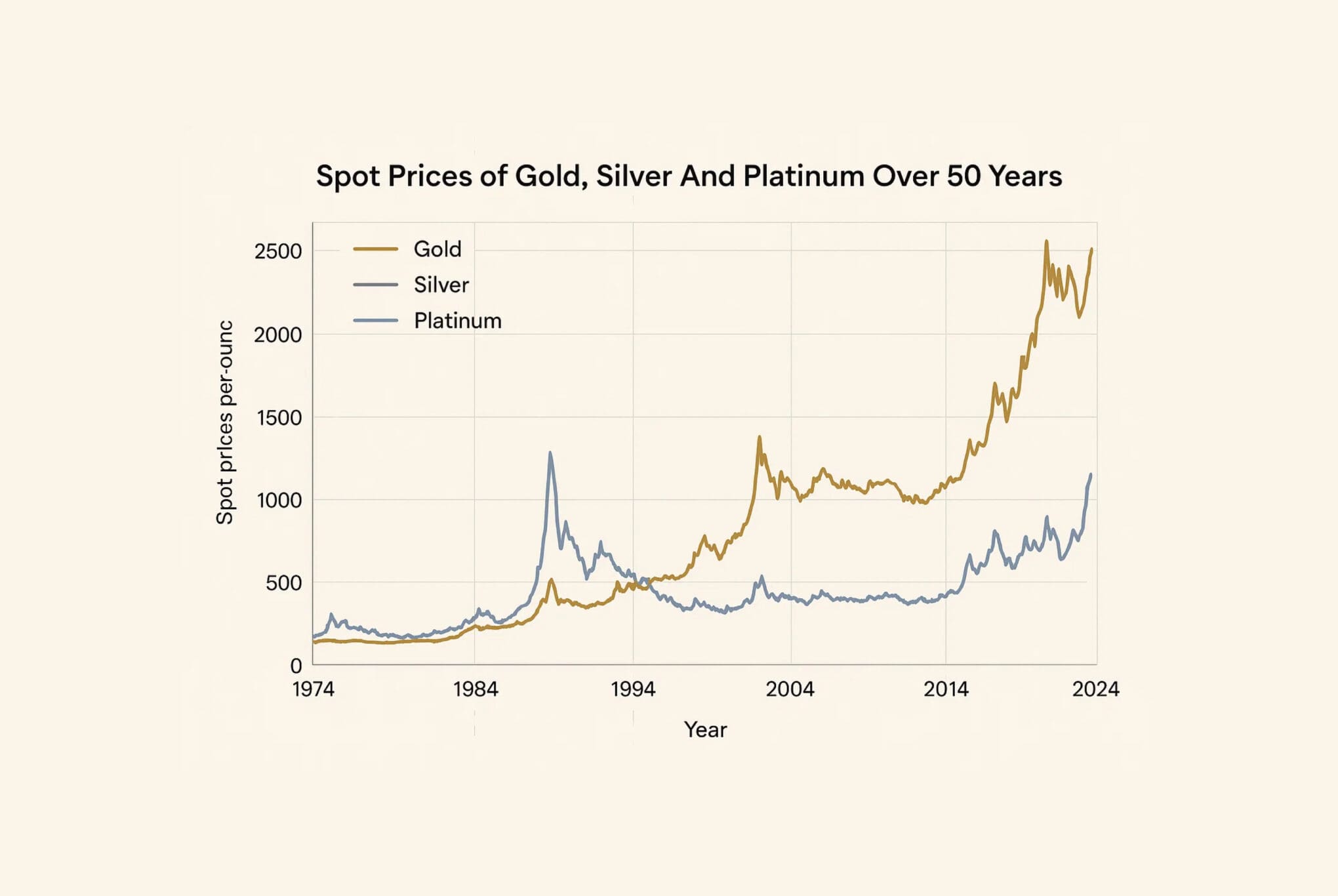You’ve checked the gold price, added a 1 oz bar to your cart… and noticed the price is higher. Why? Gold premium explained:
Welcome to the world of gold premiums—a built-in part of physical gold pricing that reflects real-world costs beyond the market rate. This guide breaks down why they exist, what they cover, and how to evaluate them with confidence. Let’s break it down.
What Is the Spot Price of Gold?
The spot price is the live trading price of gold on global markets. It’s quoted in:
- Troy ounces (31.1g)
- U.S. dollars (most commonly)
- Updated in real time
However, this is not the price you’d pay for a physical bar or coin.
What Is a Gold Premium?
A premium is the amount added above spot to account for:
- Packaging (like sealed assay cards)
- Refining and minting costs
- Transportation and insurance
- Market supply and demand
- Dealer operating expenses
So when you see a 1 oz gold bar listed at spot + $60, that $60 is the premium.
What Influences the Size of a Premium?
1. Product Type
- Coins (e.g., Eagles, Maples) typically have higher premiums than bars due to government minting, design, and collectibility.
- Bars often have lower premiums—especially in larger sizes.
2. Brand or Refiner
- Premiums may be slightly higher for PAMP Suisse or Royal Canadian Mint products due to perceived prestige and international recognition.
3. Market Conditions
- Premiums may be slightly higher for PAMP Suisse or Royal Canadian Mint products due to perceived prestige and international recognition.
4. Quantity & Size
- Smaller denominations (1/10 oz, 1/4 oz) tend to carry higher premiums due to higher relative minting and packaging costs.
- Bulk buyers often pay less per ounce.
Are Premiums Negotiable?
Generally no—but they can vary by dealer. What matters most is transparency in how the gold premium explained. Reputable sellers show:
- Live spot price
- Clear breakdown of premiums
- Total landed cost (including shipping or payment method differences)
Coins Online always displays full pricing—so you understand exactly what you’re paying for, and why.
Do Premiums Affect Resale Value?
Yes—but they don’t vanish. Buyers often pay close to melt value or slightly below, depending on:
- Current spot price
- Condition and packaging
- Brand recognition
High-demand items may retain more of their premium, especially during strong market conditions.
How to Buy Smarter
- Compare premiums, not just prices
- Stick with trusted products (Asahi, PAMP, Eagles)
- Look for bulk or free-shipping thresholds
- Check historical premium ranges during stable vs. volatile periods
Premiums reflect the real cost of real gold—not just the metal, but the security, certification, and availability behind it.
Coins Online Pricing Promise
We only carry trusted bars and coins—priced clearly, verified securely, and delivered with full transparency. No hidden fees, no surprises. We believe knowledge builds confidence. And confident customers make great collectors.
Key Points to Remember
- A gold premium bridges the gap between the live market spot price and what you pay—covering minting, packaging, and secure delivery.
- Premiums often vary based on format, brand, and market demand. Coins and smaller fractional sizes typically show higher premiums.
- Some brands like PAMP, Royal Canadian Mint, or Asahi carry a slight premium for their precision and reputation.
- At Coins Online, you’ll see spot, premium, and total cost clearly laid out before purchase—for full pricing clarity.
Collector’s Smart Shopping Checklist
- Compare premiums across similar formats (e.g., 1 oz bars vs. 1 oz coins).
- Consider the added value of assay-sealed bars for ease of documentation and resale.
- Larger bars or bulk orders often offer lower premiums per ounce; factor shipping thresholds.
- Storing premium readings periodically (during stable vs. volatile markets) helps you know when premiums are high or low.
Why Premium Transparency Matters
Understanding premiums isn’t about getting the lowest price—it’s about knowing what you’re paying for. A transparent breakdown builds collector confidence and trust in your purchase, and that’s at the heart of what Coins Online delivers.
Further Reading for Confident Gold Buyers
- How to Verify Gold Authenticity (visual and weight tests)
- What Is an Assay Certificate and Why It Matters (understand packaging and verification)
- Gold Coins vs. Gold Bars: What’s Better for Beginners? (choose your starting format)
Why This Matters for Collector Trust
At Coins Online, our goal is to support clarity, not hype. Every premium shown reflects real production and delivery costs—including assay sealing and secure packaging. That transparency gives collectors the confidence to select items knowing exactly what they’re paying for, and why it matters for authenticity, storage, and resale.
Related Reading
👉 How to Buy Physical Gold: A Complete Beginner’s Guide
👉 What Is an Assay Certificate and Why It Matters
Frequently Asked Questions About Gold Premiums
What does the ‘premium’ above spot price include?
The premium covers refiners’ costs, assay and minting, packaging, delivery, and dealer expenses.
Why do coins generally cost more over spot than bars?
Coins often carry higher premiums due to mint licensing, decorative design, and collectibility versus simpler bar formats.
How can I compare premiums effectively?
Compare the total price (spot + premium), not just spot. Then use product specs or category pages like Gold Coins vs. Gold Bars to assess comparative value.
Does brand or mint affect the premium?
Yes—a recognized refiner like PAMP, Royal Canadian Mint, or Asahi may carry a modest premium for precision, reputation, and assay certification.
Do premiums affect resale value?
Premiums may erode upon resale, especially outside peak markets, but items with intact assay packaging and strong mints may retain value better.


Leave a Reply